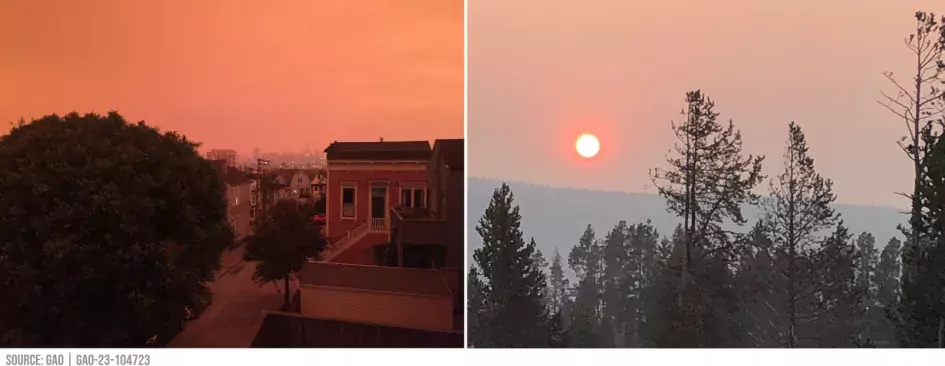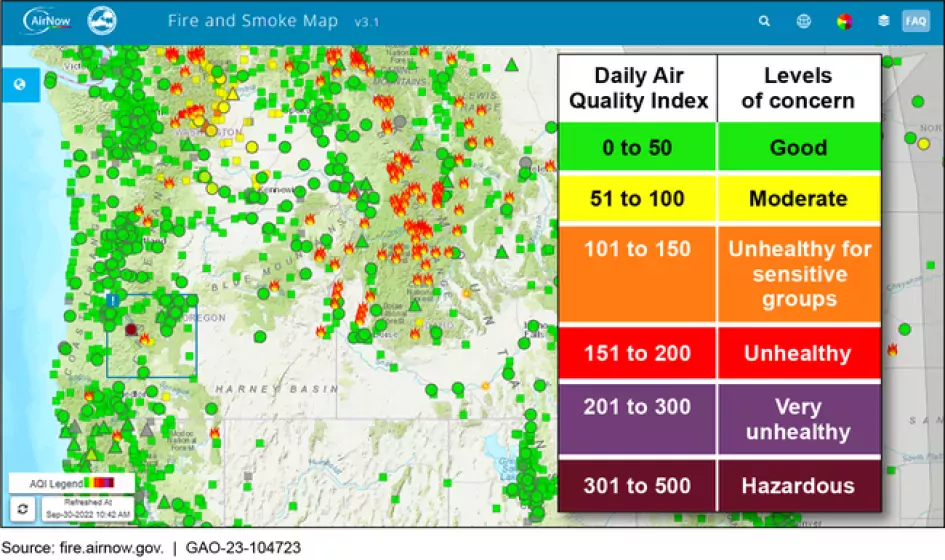Worsening Wildfire Smoke Requires a More Proactive Approach
The U.S. has recently experienced some of its worst wildfire seasons on record, creating unhealthy smoke that affected tens of millions of Americans. Physical health effects from wildfire smoke exposure can range from breathing difficulties to heart failure. Certain populations—including children and older adults—are at higher risk from these effects. Wildfire smoke can also affect people’s mental health when smoke forces them to stay indoors or avoid recreational activities for days or weeks at a time.
Wildfires are expected to become more frequent and intense as a result of climate change. And the Environmental Protection Agency (EPA) says this is a vulnerability that may affect its ability to meet mission and air quality goals. In today’s WatchBlog post, we take a look at our new report on the challenges increasingly catastrophic wildfires have created and the steps needed to more proactively address them long term.
Smoke from the Marshall Fire in Boulder County, CO on December 30, 2021
Image

Communities have been engulfed in wildfire smoke
While wildfires have mostly been associated with the western U.S., their effects are being increasingly felt across the country. For example, in July 2021 smoke from wildfires in the western U.S. and Canada, including the Bootleg Fire in Oregon, prompted unhealthy air quality alerts as far east as New York City and Washington, D.C.
Still, the communities seeing the greatest impact are those out west. We interviewed officials from some of the communities most affected by wildfires. They told us wildfire smoke has been progressively worsening in recent years, affecting the health of their communities.
For example:
- Clark County, Nevada—home of Las Vegas—contends with wildfire smoke 5 months out of the year (from May through September), with smoke episodes that often last multiple days or weeks.
- In Oregon, one community was polluted with wildfire smoke nearly every day for 2 months, starting in August 2021.
- In Missoula, Montana, officials said high levels of wildfire smoke created notable impacts on air quality for 5 of the 10 years, from 2012 to 2021. Officials said 2017 was particularly bad, with over a month of continuous wildfire smoke.
- In California, 2020 was a particularly bad wildfire year with over 95% of the state’s population of about 39 million experiencing one or more days of poor air quality. An official from the Yurok Tribe, located in California, said that worsening wildfire smoke has negatively affected the health of tribal members, including babies and elders.
Wildfire Smoke in San Francisco (left) and Yellowstone National Part (right) in 2020
Image

EPA is helping communities prepare for wildfire smoke, but a more proactive approach is needed
Wildfires and wildfire smoke are inevitable, so EPA has focused its work on helping communities prepare for and respond to smoke episodes, often times, coordinating with other federal agencies. For example, EPA works with the Forest Service to provide information and tools, such as in the map below, which is available online and updated regularly. This can help communities and individuals understand how bad the air quality is during a fire. This information can help people make decisions about how to protect themselves and their families, such as whether they should avoid outdoor exercise, run a portable air filter, or wear an N95 mask.
Fire and Smoke Map with Information about Fire Locations, Smoke Plumes, and Air Quality
Image

We found that EPA’s efforts to help communities prepare for and respond to wildfire smoke episodes have been ad hoc and spread out across the agency, with no program or staff solely dedicated this work. This may prevent the agency from targeting the limited resources it has to the highest priorities that can best help communities. We recommended that EPA better coordinate within the agency on these efforts.
While it’s important to work with communities to prepare for and respond to smoke episodes, EPA can also enhance its role in supporting efforts that can help reduce the amount of smoke from wildfires. These wildfire risk mitigation efforts include certain measures, such as “prescribed burns,” that are implemented by federal land management agencies and other land managers to help decrease the intensity of wildfires, and thereby the amount of smoke they produce. By enhancing its role in supporting wildfire risk mitigation, EPA could help more proactively and effectively reduce smoke risks over the long term. To do this, we recommended that EPA—in some cases with the Forest Service and Department of the Interior— take steps to better coordinate, provide information about reducing wildfire smoke risks, and incentivize and support wildfire risk mitigation at the tribal, state, and local levels.
Learn more about EPA’s efforts to address growing wildfire smoke concerns by reading our new report.
- Comments on GAO’s WatchBlog? Contact blog@gao.gov.
GAO Contacts
Related Products

GAO's mission is to provide Congress with fact-based, nonpartisan information that can help improve federal government performance and ensure accountability for the benefit of the American people. GAO launched its WatchBlog in January, 2014, as part of its continuing effort to reach its audiences—Congress and the American people—where they are currently looking for information.
The blog format allows GAO to provide a little more context about its work than it can offer on its other social media platforms. Posts will tie GAO work to current events and the news; show how GAO’s work is affecting agencies or legislation; highlight reports, testimonies, and issue areas where GAO does work; and provide information about GAO itself, among other things.
Please send any feedback on GAO's WatchBlog to blog@gao.gov.




